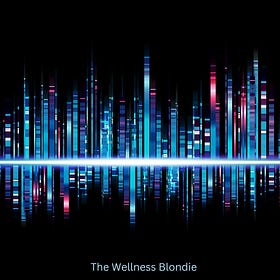Healing Frequencies That Feel Like an Exorcism
Because apparently, my nervous system didn’t get the memo on “relaxation.
Join me for a dose of snarky humor and witty commentary as I share the ups, downs, and lessons learned while navigating life, marriage, and parenting nuerospicy kids with an ADHD partner—all while trying to embrace the crunchy lifestyle!Why Some Healing Frequencies Hurt Instead of Heal (Ah yes, the miracle cure that backfired—classic!)
I first learned about sound frequencies on a podcast and was intrigued. They often recommended 528 Hz as a powerful frequency for healing and repair, so I downloaded an app and started experimenting.
But instead of feeling relaxed, I felt awful. 528 Hz would wake me up in the middle of the night, trigger headaches, and even cause body aches. It wasn’t soothing in any way. Frustrated, I wondered if I had been duped by all the hype.
Then it hit me—could this have something to do with my dysregulated nervous system? Because of course, my body just loves to overreact to everything. I dug into the research, and here’s what I found.
Why Do Certain Frequencies Hurt Instead of Heal?
If you have a dysregulated nervous system, ADHD, Autism, or CPTSD, certain sound frequencies may not work for you as expected. Instead of healing, they can feel overstimulating or even painful. Here’s why:
1. Nervous System Dysregulation & Sensory Sensitivities
If your nervous system is already overactive or dysregulated, your brain may struggle to process certain sensory inputs—like sound frequencies—properly.
Some people experience auditory hypersensitivity, where certain tones or pitches feel overwhelming.
Frequencies designed for relaxation might actually agitate an already overactive nervous system, making symptoms worse.
2. ADHD & Auditory Processing
People with ADHD often have sensory processing differences, meaning their brain interprets sounds differently.
Certain frequencies might be too stimulating, triggering headaches or discomfort instead of relaxation.
Background noise or repetitive sounds may increase restlessness rather than calmness.
3. Autism & Sound Sensitivity
Many autistic individuals experience hyperacusis (heightened sound sensitivity), where specific frequencies can feel physically painful or cause anxiety.
528 Hz or other high frequencies might be processed differently, making them irritating instead of calming.
4. CPTSD & Trauma Responses
If you have CPTSD, your nervous system may be stuck in a chronic fight-or-flight state.
Sound frequencies, especially repetitive or high-pitched ones, can trigger a stress response rather than relaxation.

What Can You Do?
If a frequency isn’t working for you, it’s okay to listen to your body and adjust. Here are some tips: ✔ Lower the volume – Even “healing” frequencies can be overwhelming if they’re too loud. ✔ Experiment with different frequencies – Some people find lower tones (like 432 Hz) more soothing. ✔ Pay attention to timing – A frequency that feels bad when you’re stressed might feel better when you’re calm. ✔ Trust your body – If a frequency doesn’t feel good, it’s not for you—and that’s okay!
Finding the Right Frequency: Why 285 Hz Feels Good
While 528 Hz felt awful, I noticed that 285 Hz felt great—calming, grounding, and almost like a relief. This got me thinking: could lower frequencies actually work opposite of how they’re described?
Why Lower Frequencies Might Work Better for a Dysregulated Nervous System
Lower frequencies (like 285 Hz) resonate with slower brainwaves (like Delta and Theta), which are linked to relaxation, grounding, and deep healing.
Higher frequencies (like 528 Hz) can be too stimulating, triggering headaches, anxiety, or agitation.
Your body might interpret “energizing” or “liberating” frequencies as overstimulation, while lower frequencies bring balance.
Should You Look Into Opposites?
Yes! If a frequency is marketed as “energizing” or “activating,” but you find it agitating, you might need to do the opposite. Instead, look for grounding, stabilizing, or soothing frequencies.
Frequencies You Might Like Based on Your Response to 285 Hz
⭐ 285 Hz → Healing & cellular repair (already works for you!)
⭐ 174 Hz → Deep grounding, relieves stress and tension
⭐ 396 Hz → Anxiety & fear release (can feel calming)
⭐ 432 Hz → Nature’s frequency, often used for relaxation
🚫 500 Hz and up → These tend to be more activating, so if they feel overstimulating, they might not be the best fit.
Listening Tips for a Dysregulated Nervous System
🎧 Try different frequencies at low volumes and see how your body responds.
📌 Notice how you feel before and after—if a frequency is truly working, you should feel more balanced, not agitated.
⏳ Use frequencies intentionally—for example, grounding ones in the morning and relaxing ones at night.
Trust What Feels Good
If your body tells you 285 Hz works- trust that! You don’t have to force yourself into “healing” frequencies that don’t feel right. Sound healing is personal, and it’s okay to customize your experience to what truly soothes you.
💬 Tried sound healing and felt like your brain was under attack? Let’s compare notes!? Which frequencies work best for you? Drop a comment—I’d love to hear your experience! 🎶💙
Love my snarky takes on marriage, parenting, and the chaos of raising an AuDHD-fueled family—while still trying to live that crunchy dream, but do not want to upgrade to paid? Help keep the laughs rolling, the sourdough rising, and the wellness wisdom flowing. Toss a few bucks my way—because organic sarcasm and real talk deserve a little funding. 😉More to Explore
Unlocking the Power of Frequencies
In recent years, the use of sound frequencies to improve well-being has gained significant attention. By harnessing the power of specific frequencies, you can enhance your sleep quality, uplift your mood, and support overall mental and emotional health. In this blog post, we'll explore how these frequencies work, which ones are particularly effective, a…


